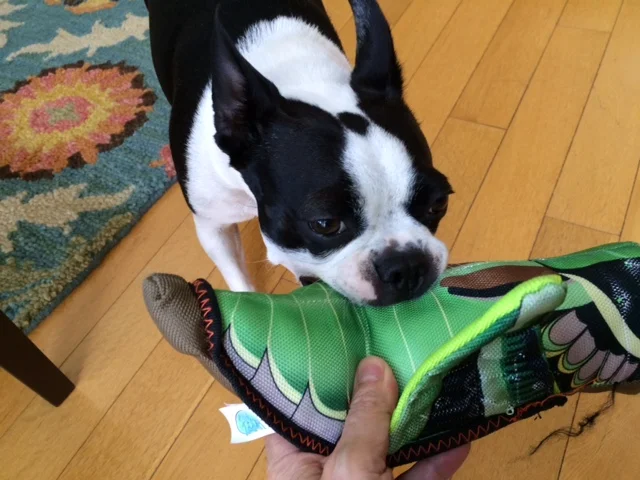When I was ten, my childhood friend, Steve, and I could barely resist playfully slapping each other around every now and then.
It was generally good-natured fun. Invariably, though, one of us would land a blow that left behind a handsome welt - and second thoughts about the other’s motivations. Our parents shrugged the practice off as a “boy thing” - which we did eventually outgrow.
But rough-housing has found a resurgence in my mid-later years after I became a pet parent. My wife’s and my first dog, Louie, and I used to wrestle in the living room after dinner (our poor hardwood floors!). Nowadays, our Lilly, the Boston terrier, and I will rumble just about anytime, anywhere - with any toy that has two ends (I’ve learned not to wear fabrics that easily unravel!).
Rough-housing is primal. It’s fun. But is it ever too much?
Some dog behaviorists and trainers agree that rough play is a-okay - so long as rules and limits are well-defined and exercised. When we humans assume the roles of playmate and referee during playtime, there’s virtually no chance that our perky pooch will morph into The Werewolf of London.
Responsible, vigorous play offers an array of benefits to both dogs and humans. Play can provide a fun intro to other people and other dogs. It also fires those synapses by keeping dogs engaged. Anyone on two legs or four can pop their cork occasionally and play is a great tension-reliever. And exercise? Who wants to trek on a treadmill when you can chase, tug, catch, roll, duck and dodge with a partner? Within a solid structure, play may just be the best training tool there is.
Toward that end, here are a few suggestions for keeping hearty play safe and fun:
- We as pet parents must take the lead. That means initiating play, signaling a break time and ending the play session. I confess that I am sometimes guilty of violating this rule, because, well, it’s just so damn cute when Lilly races over to me with her mouthful of stuffed grasshopper and nudges it into my knee. Indulge her persistence too often and I run the risk of reversing our roles!
- Create a special cue to signal rough play. I will actually get down on all fours, dip into a play-bow, grab Lilly’s toy and growl, “It’s mine!” Never fails!
- Set limits on acceptable rough play. For some pet parents, mouthing is okay but biting down crosses the line; for others, light biting is welcome. We need to establish our boundaries and enforce them. If our line is crossed during play, simply drop the toy, say something like “All done!” and turn/walk away. I want Lilly to learn that play is special time and that she should not jeopardize that.
- Insert frequent breaks in rough play. After a minute or two of rough-housing, I will release Lilly’s toy and say, “Drop it” and wait until she does. I then say, “Leave it,” which she does. Teaching Lilly to stop and start prevents her from getting worked up into a tizzy. When the play/stop cycle is accompanied by music stopping and starting, it becomes a canine version of musical chairs.
- Beware of any changes in the dog’s body language or voicing. A drooping head with ears pinned back and tail curled under means “Back off!” Growling that drops from high-pitched bursts to a low, long and guttural groan means “I may bite - for real!”
- Reward good behaviors to make them stick: special treats and/or more play with another favorite toy is the ticket.
Over time, a dog can come to associate the unique style and roughness of play of each family member or friend, so it's unlikely that Tank will tumble the same way with a 10-year-old girl as with a full-grown man. As always, however, dog play with children should be closely supervised. Kids should be taught that dogs are beings with moods and feelings, not objects to be yanked or jumped on.
Despite precautions and vigilance, minor injuries can occur. Five years ago, I got skewered with a tetanus shot because Louie - in his play frenzy - couldn’t tell where his Kong ended and the webbing between my fingers began. But that was on me for carrying Louie’s playful zeal over the line.
Too many human behaviors have taught aggression to dogs. Responsible rough play will never be among them.

